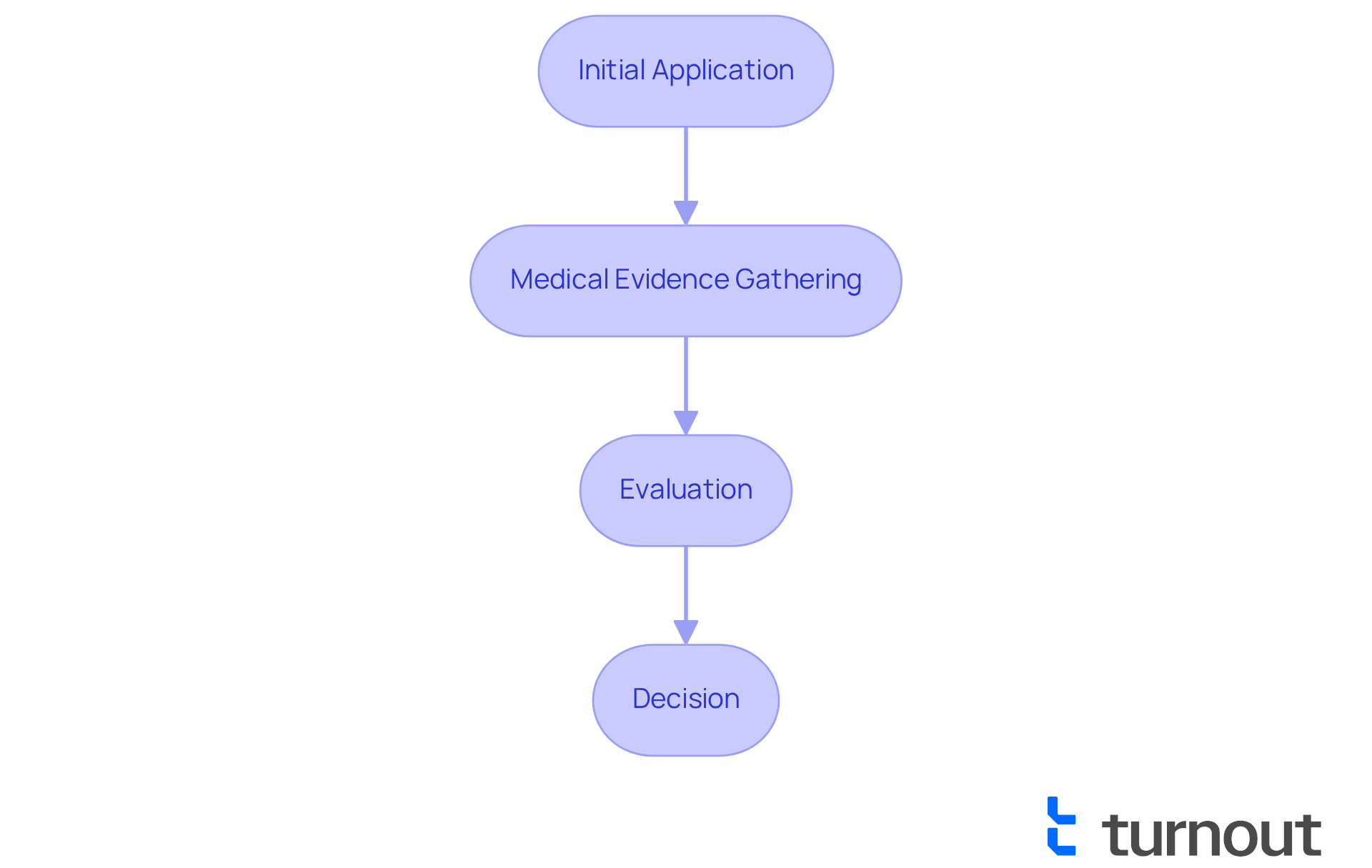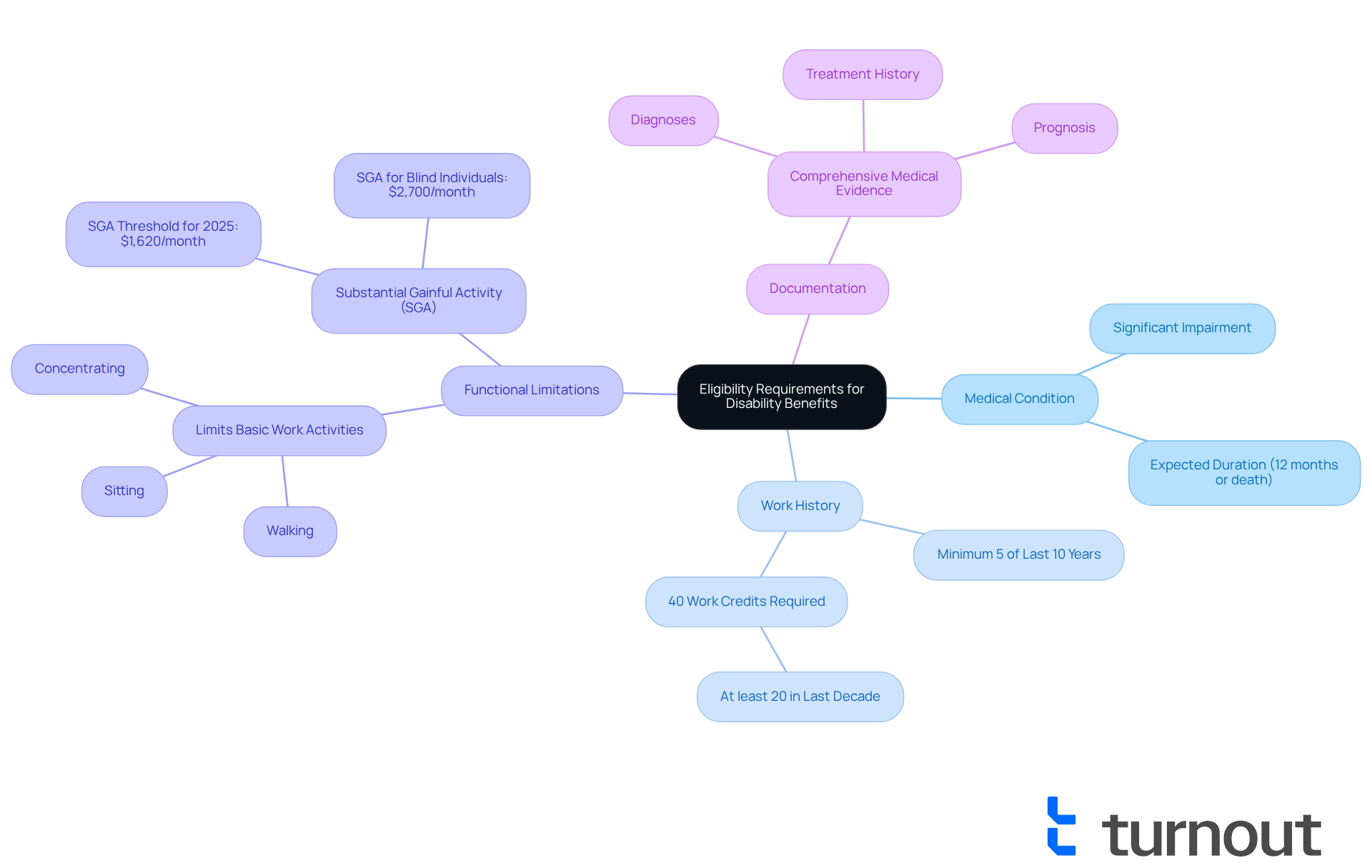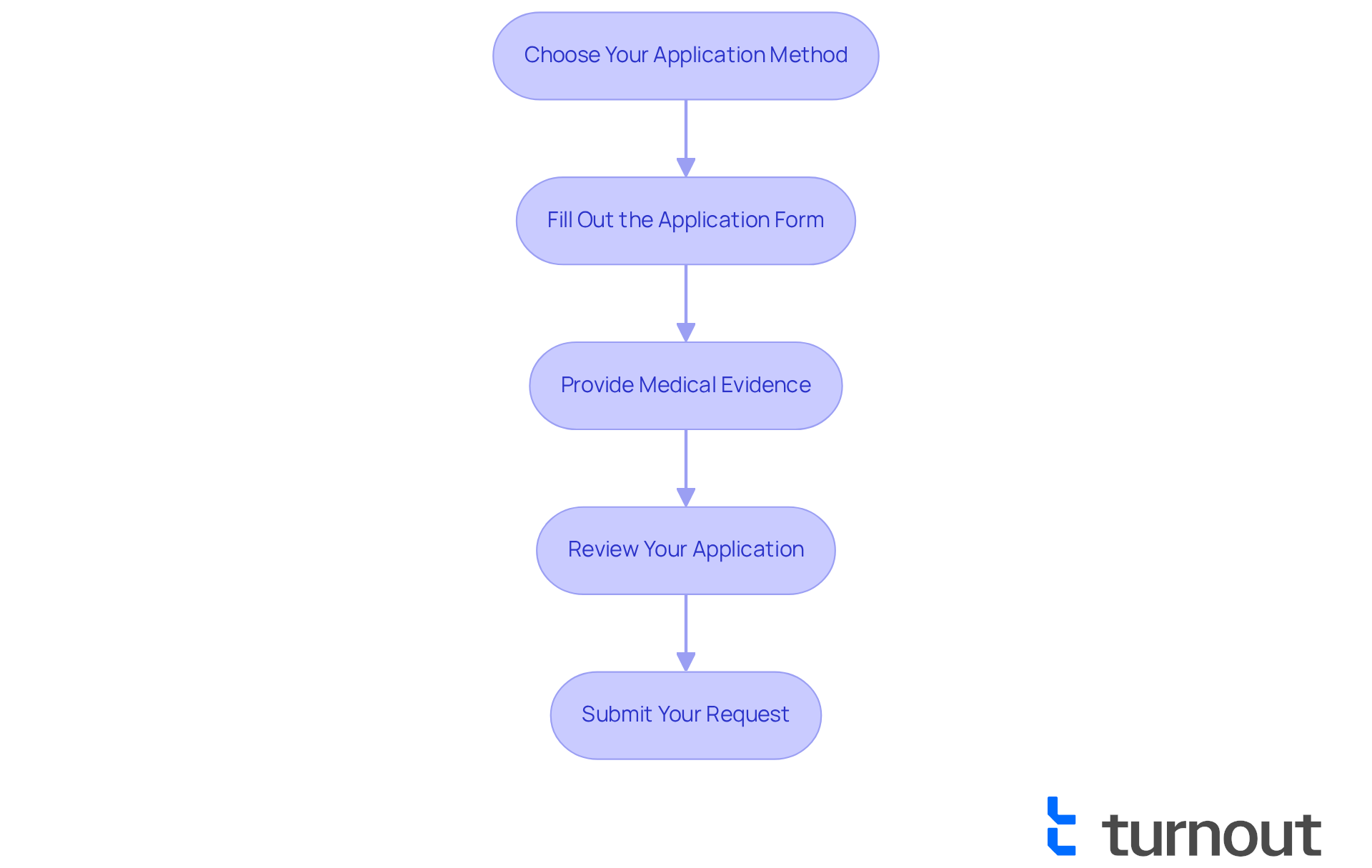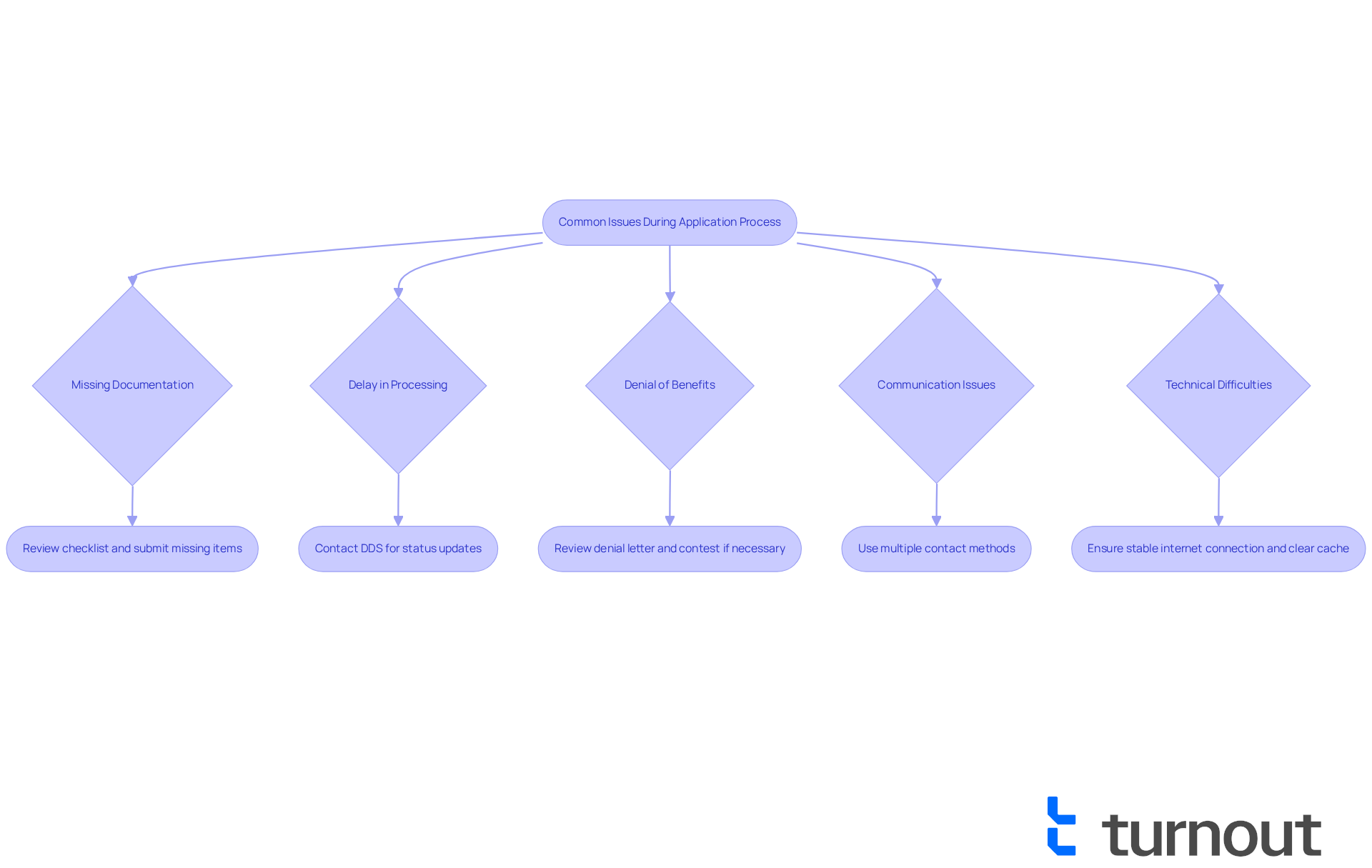Overview
Navigating the Disability Determination Services process can feel overwhelming. We understand that many applicants face significant challenges, from missing documentation to frustrating delays. It’s common to feel anxious, especially knowing that over half of claims are initially denied. But don’t lose hope—thorough preparation and support can make all the difference.
To master this process, follow these five essential steps:
- Submit your initial application: Ensure all required information is included.
- Gather medical evidence: Collect documentation that supports your claim.
- Evaluation: Understand how your case will be assessed.
- Decision: Be prepared for the outcome, whether it’s approval or denial.
- Potential appeals: If denied, know that you can appeal the decision.
Remember, you are not alone in this journey. Many have walked this path and found success with the right guidance. It’s crucial to seek informed assistance to navigate the complexities of the process. With the right support, you can overcome the hurdles and achieve your goals. We’re here to help you every step of the way.
Introduction
Navigating the Disability Determination Services process can often feel like an uphill battle. With countless forms, eligibility requirements, and potential pitfalls, it’s easy to feel overwhelmed. We understand that this journey can be daunting, but knowing the essential steps can demystify the process and empower you to tackle your claims with confidence.
However, it’s common to feel discouraged when over half of disability claims face initial denial. So, how can you ensure your application stands out in such a complex system? This guide outlines five crucial steps to master the process. By following these insights and strategies, you can enhance your chances of a successful outcome. Remember, you are not alone in this journey; we’re here to help.
Understand the Disability Determination Services Process
Navigating the disability determination services process can feel overwhelming, but understanding the essential steps can make a significant difference. Here’s a breakdown of what to expect:
- Initial Application: Once you submit your application, it undergoes a thorough review for completeness. It’s crucial to provide all required information to avoid unnecessary delays.
- Medical Evidence Gathering: The DDS will gather medical records and relevant information to assess your condition. This may involve reaching out to your healthcare providers for additional paperwork.
- Evaluation: A disability examiner will analyze your case, considering medical evidence, work history, and other relevant factors to determine if you meet the Social Security Administration's (SSA) criteria for disability.
- Decision: After the evaluation, you’ll receive a decision regarding your claim. If approved, you’ll learn about your benefits; if denied, you’ll have the chance to appeal.
We understand that these steps can be daunting, especially with the average processing time for claims now exceeding seven months—specifically averaging 7.7 months as of August 2024. This reflects the challenges many applicants face, and it’s common to feel anxious during this time.
That’s why it’s so important to have support. This organization is dedicated to simplifying access to benefits, offering expert guidance through trained advocates who can assist you in preparing your application and gathering necessary documentation. Remember, Turnout is not a law firm and does not provide legal advice, but we’re here to help you navigate this journey.
Real-world examples show that persistence can lead to success. Many individuals have successfully navigated the disability determination services process despite initial setbacks. Advocates emphasize that being well-prepared and informed can significantly enhance your chances of a favorable outcome. It’s also important to be aware that over half of SSDI and SSI disability claims are initially denied, highlighting the potential challenges you may encounter.
You are not alone in this journey. With the right preparation and support, you can increase your chances of success.

Identify Eligibility Requirements for Disability Benefits
Navigating the world of disability benefits can feel overwhelming, but understanding the eligibility requirements set by the Social Security Administration (SSA) is a crucial first step. Here’s what you need to know:
- Medical Condition: You must have a medical condition that significantly impairs your ability to work. This condition should be expected to last at least 12 months or result in death.
- Work History: Generally, you need to have worked for at least 5 of the last 10 years and paid Social Security taxes. For 2025, applicants typically need a total of 40 work credits, with at least 20 earned in the last decade before the onset of the disability.
- Functional Limitations: Your condition must limit your ability to perform basic work activities, such as walking, sitting, or concentrating. The substantial gainful activity (SGA) threshold for 2025 is set at $1,620 per month, or $2,700 for individuals classified as blind.
- Documentation: Providing comprehensive medical evidence that supports your claim is essential. This includes diagnoses, treatment history, and prognosis. We understand that navigating the disability determination services process can be intricate and demands careful attention.
Recent updates indicate that in 2025, SSDI policy changes may impact eligibility through cost-of-living adjustments and updated earnings thresholds. Staying informed about these changes is vital, as they could affect the percentage of applicants meeting SSA eligibility criteria. For instance, a projected 10 percent reduction in SSDI eligibility could lead to 500,000 individuals losing access to benefits over the next decade. This highlights the importance of thoroughly understanding these requirements.
By examining these criteria closely, you can more effectively evaluate your eligibility and prepare for the next steps in the disability determination services process. Remember, you are not alone in this journey, and we’re here to help.

Gather Required Documentation for Your Application
Before you send in your request, it’s essential to gather all the necessary paperwork. We understand that this process can feel overwhelming, so here’s a helpful checklist of what you typically need:
- Personal Identification: Make sure to include your Social Security number, birth certificate, and proof of U.S. citizenship or lawful residency.
- Medical Records: Obtain detailed medical records from your healthcare providers. This should include diagnoses, treatment plans, and relevant test results. Having robust medical records is crucial, as the SSA mainly examines information from the 12 months leading up to your application in the disability determination services process.
- Work History: Prepare a summary of your work history. Detail your job titles, dates of employment, and descriptions of your job duties. The SSA now requires documentation covering the last five years of employment.
- Financial Information: If applicable, provide information about your income and assets, as this may be relevant for certain benefits. Ensure your earnings fall below the Substantial Gainful Activity limit, which is $1,620 per month in 2025 for SSDI applicants, and $2,700 per month for blind individuals.
- Additional Forms: Complete any required forms, such as the SSA-16 for disability benefits. You may also want to submit a checklist to ensure all necessary documents are included, as missing paperwork can lead to delays or denials.
It’s important to remember that Turnout is not a law firm and does not provide legal representation. Having these documents prepared will simplify your submission and help prevent avoidable delays. Many successful candidates emphasize the importance of comprehensive records, as they significantly impact the disability determination services process and the assessment of your claim.
Additionally, consider using the Disability Starter Kit as part of the disability determination services process. It offers vital details about necessary documents and the decision-making process, helping you manage your submission more efficiently. Remember, Turnout's trained nonlawyer advocates are here to assist you in ensuring that you have all the necessary documentation ready. You are not alone in this journey.

Complete the Application for Disability Benefits
Completing your application for disability benefits can feel overwhelming, but we're here to assist you through the disability determination services process. Follow these steps to make the process smoother:
-
Choose Your Application Method: You have options! Apply online through the SSA website, by phone, or in person at your local SSA office. Recent changes have made online submissions quicker and easier than ever, so consider this method if you can.
-
Fill Out the Application Form: If you’re applying online, head to the right section and fill out the SSA-16 form. It’s important to ensure all your information is accurate and complete. Remember, attention to detail matters; missing or incorrect information can lead to denials, especially if your medical history isn’t fully documented.
-
Provide Medical Evidence: Don’t forget to attach your medical records and any other necessary documents. The SSA needs detailed medical evidence, including records from licensed healthcare providers, to support your claim. Inadequate records are a common reason for rejection, so be thorough.
-
Review Your Application: Before you hit submit, take a moment to double-check everything. Make sure all required fields are filled out and that you’ve included all necessary documentation. Keeping a personal disability journal can be beneficial, as it helps illustrate how your condition affects your daily life.
-
Submit Your Request: Once you’ve completed everything, it’s time to submit your request. If you’re applying online, you’ll receive a confirmation right away. If you’re mailing it in, consider using certified mail for tracking. This step is crucial; timely submission can significantly impact your approval timeline.
By following these steps carefully, you can help ensure that your submission is processed smoothly within the disability determination services process. We understand that the initial assessment of a disability application usually takes 3-5 months, but with careful preparation, you might be able to speed up the disability determination services process. Remember, while we’re here to assist you, we’re not a legal practice and don’t provide legal guidance. Our trained non-legal advocates are available to support you every step of the way. You are not alone in this journey.

Troubleshoot Common Issues During the Application Process
Navigating the submission process can be challenging, and it's common to encounter a few bumps along the way. Here’s how to tackle some typical issues with care and support:
-
Missing Documentation: If you receive a notice saying your application is incomplete, don’t worry. Take a moment to review the checklist of required documents and submit any missing items. A 2020 audit revealed that 67 out of 100 notices had issues with accuracy and completeness, highlighting the importance of detailed records. Remember, Turnout's trained nonlawyer advocates are here to help ensure that all necessary documentation is submitted correctly. Just keep in mind that Turnout does not provide legal representation.
-
If your request is taking longer than expected during the disability determination services process, it’s perfectly okay to reach out to the Disability Determination Services (DDS) office to check on the status. Be prepared to share your submission details. With over 1 million initial claims pending as of April 2025, delays are quite common, so staying informed is crucial. This resource can guide you in managing these delays and offer tips on how to follow up effectively.
-
Denial of Benefits: If your application is denied, take a deep breath and carefully review the denial letter to understand the reasons behind it. Insufficient recent work credits are often the leading non-medical reason for denial. You have every right to contest the decision, and getting help from a support group can significantly boost your chances of success as they specialize in assisting clients through the appeals process.
-
Communication Issues: If you’re having trouble reaching the DDS or getting updates, consider using multiple contact methods, like phone and email, to ensure your inquiries are addressed. It’s not uncommon for hold times on the SSA’s helpline to exceed five hours, so persistence is key. Supporters of the initiative can also help facilitate communication with the disability determination services process to ensure your concerns are heard.
-
Technical Difficulties: If you’re applying online, make sure your internet connection is stable. If you run into technical issues, try clearing your browser cache or switching to a different browser. The SSA is in the process of transitioning to a new digital claims system, which aims to streamline processing but may introduce temporary glitches. Participation can provide assistance in overcoming these technical hurdles, ensuring you can complete your submission smoothly.
By being proactive and ready to address these common issues, you can navigate the application process more effectively. Remember, many successful claims are won at the administrative law judge hearing level, so understanding the appeals process is vital. You are not alone in this journey—Turnout is here to support you every step of the way.

Conclusion
Navigating the Disability Determination Services (DDS) process can feel overwhelming. We understand that this journey is filled with challenges, but knowing the essential steps and requirements can truly empower you to secure the benefits you need. This guide has highlighted the critical phases, from the initial application to gathering necessary documentation and troubleshooting common issues. Preparation and support are key throughout this process.
One important insight is the need for comprehensive medical evidence. Understanding eligibility requirements is crucial, too. It’s common to face challenges like application delays and denials. Did you know that over half of initial claims are denied? Being well-informed and prepared can significantly enhance your chances of a successful outcome.
Ultimately, obtaining disability benefits requires persistence and thoroughness. By leveraging available resources and seeking support from trained advocates, you can navigate the complexities of the DDS process with greater confidence. This journey may be challenging, but with the right preparation and guidance, achieving a favorable outcome is within reach. Remember, you are not alone in this journey; we’re here to help.
Frequently Asked Questions
What is the first step in the disability determination services process?
The first step is the initial application, which undergoes a thorough review for completeness. It's important to provide all required information to avoid delays.
How does the Disability Determination Services (DDS) gather medical evidence?
The DDS gathers medical records and relevant information by reaching out to your healthcare providers for additional paperwork to assess your condition.
Who evaluates the disability claim and what do they consider?
A disability examiner evaluates the claim, considering medical evidence, work history, and other relevant factors to determine if you meet the Social Security Administration's (SSA) criteria for disability.
What happens after the evaluation of a disability claim?
After the evaluation, you will receive a decision regarding your claim. If approved, you’ll learn about your benefits; if denied, you have the opportunity to appeal.
What is the average processing time for disability claims?
As of August 2024, the average processing time for claims exceeds seven months, specifically averaging 7.7 months.
How can support help during the disability determination services process?
Support can simplify access to benefits and provide expert guidance through trained advocates who can assist in preparing your application and gathering necessary documentation.
What percentage of SSDI and SSI disability claims are initially denied?
Over half of SSDI and SSI disability claims are initially denied, highlighting the potential challenges applicants may face.
What are the medical condition requirements for eligibility for disability benefits?
You must have a medical condition that significantly impairs your ability to work, expected to last at least 12 months or result in death.
What work history is generally required to qualify for disability benefits?
Generally, you need to have worked for at least 5 of the last 10 years and paid Social Security taxes, typically requiring a total of 40 work credits, with at least 20 earned in the last decade before the onset of the disability.
What are functional limitations in the context of disability benefits?
Your condition must limit your ability to perform basic work activities, such as walking, sitting, or concentrating. The substantial gainful activity (SGA) threshold for 2025 is set at $1,620 per month, or $2,700 for individuals classified as blind.
Why is documentation important in the disability benefits application process?
Providing comprehensive medical evidence that supports your claim, including diagnoses, treatment history, and prognosis, is essential for a successful application.
How might SSDI policy changes affect eligibility in 2025?
SSDI policy changes may impact eligibility through cost-of-living adjustments and updated earnings thresholds, potentially leading to a projected 10 percent reduction in SSDI eligibility, affecting around 500,000 individuals over the next decade.




